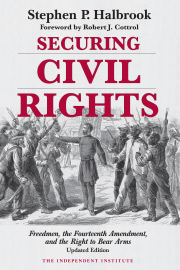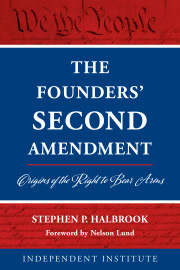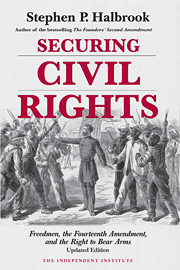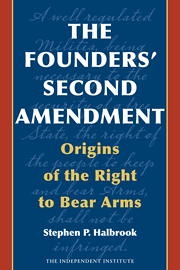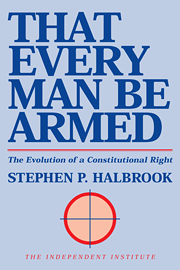The Third Circuit heard oral argument on March 11 in a challenge to Delaware’s ban on so-called “assault weapons” and ammunition magazines that hold over 17 rounds. Three overlapping cases were consolidated for argument on appeal from the denial of a preliminary injunction. Before the Court got into the meat of the Second Amendment dispute, Judge Stephanos Bibas raised a question about the preliminary injunction standard as it applies in Second Amendment cases: do the plaintiffs need to show that every preliminary injunction factor weighs in their favor, or is it enough to show they are likely to succeed on the merits?
The Supreme Court refers to the preliminary injunction as “an extraordinary remedy” that requires plaintiffs to make a “clear showing” on four factors before being granted: (1) likelihood of success on the merits, (2) that they face irreparable harm in the absence of an injunction, (3) that the balance of the equities favor them, and (4) that the public interest would be served by the injunction. The plaintiffs in Delaware focused on the first point—that they were likely to show the laws they challenged violate their Second Amendment rights. Judge Bibas questioned whether that was enough.
It should be. In fact, while there are putatively four factors to be considered in granting a preliminary injunction, in litigation against the government over the constitutionality of a law, in practice they tend to collapse. In such cases, “likelihood of success” is “the first among equals” and is typically dispositive, L.W. by & through Williams v. Skrmetti (6th Cir. 2023), and the third and the fourth factors, the public interest and the balance of the equities are considered as one. Nken v. Holder (U.S. 2009). Furthermore, if plaintiffs show that the law they challenge violates the Constitution, then those final factors necessarily weigh in their favor, because “the enforcement of an unconstitutional law vindicates no public interest.” K.A. ex rel. Ayers v. Pocono Mountain School District (3d Cir. 2013).
The same should be true for irreparable harm as well, as the Ninth Circuit recognized in its Second Amendment decision in Baird v. Bonta (2023), where it explained that “in cases involving a constitutional claim, a likelihood of success on the merits usually establishes irreparable harm, and strongly tips the balances of equities and public interest in favor of granting a preliminary injunction.”
Irreparable harm was the focus of Judge Bibas’s questioning in the Delaware argument. It is black-letter law, as the Supreme Court held in 2020 in Roman Catholic Diocese of Brooklyn v. Cuomo, that “[t]he loss of First Amendment freedoms, for even minimal periods of time, unquestionably constitutes irreparable injury.” There is every reason to think the same is true for the Second Amendment. “Irreparable harm” is an injury that cannot be easily measured in (and therefore compensated by) monetary damages. Some circuits have recognized that any constitutional right deprivation is necessarily “irreparable.” Melendres v. Arapaio (9th Cir. 2012). And the Third Circuit has extended it at least to cover Fourth Amendment rights, noting that “[p]ersons who can establish that they are being denied their constitutional rights are entitled to relief, and it can no longer be seriously contended that an action for money damages will serve to adequately remedy unconstitutional searches and seizures.” Lewis v. Kugler (1971). As the Supreme Court made clear in New York State Rifle & Pistol Association v. Bruen (2022), the Second Amendment deserves equal treatment with the other protections in the Bill or Rights.
In alignment with this, the Seventh Circuit in Ezell v. City of Chicago (2011) answered Judge Bibas’s question well when it noted that “[t]he loss of a First Amendment right is frequently presumed to cause irreparable harm based on the intangible nature of the benefits flowing from the exercise of those rights. . . . The Second Amendment protects similarly intangible and unquantifiable interests. Heller held that the Amendment’s central component is the right to possess firearms for protection. Infringements of this right cannot be compensated by damages.”
The limited scenarios in which a constitutional injury does not entitle a litigant to injunctive relief—in the Fifth Amendment takings context, for instance, where the proper remedy is money damages—supports the line the Seventh Circuit drew between “tangible” and “intangible“ (but nevertheless real) injuries. Where plaintiffs show a likelihood of success in proving such an intangible injury, it follows that their injury is “irreparable” in nature.
At the Delaware argument, one of the attorneys defending the law argued that an injunction should not be the automatic result in a case showing likelihood of success in proving a constitutional violation, pointing to the Purcell principle. The Purcell principle, named after the Supreme Court case Purcell v. Gonzalez (2006), is the rule that courts should ordinarily not enjoin challenged election laws shortly before an election is set to occur, out of concern that such an injunction could result in voter confusion. But the Purcell principle is the exception that proves the rule—it speaks only to a very narrow circumstance where an injunction should not enter immediately (though to be sure, election laws can be enjoined immediately after the election upon a showing of constitutional infirmity) because of unique concerns about the fairness of elections. That the Delaware law’s defenders would look to such a dissimilar context shows how little they have to support their position.
One other point of interest from this argument. The Third Circuit panel showed some concern that the plaintiffs were pointing to information that was not technically in the preliminary injunction “record” of evidence submitted to the trial court. Judge Bibas asked the attorney for Delaware whether it was appropriate to look at such evidence because it went toward proving certain “legislative facts.” The attorney’s responded, “The very fact that they are citing expert declarations that plaintiffs in other cases chose to submit to those courts, but that for whatever reason, these plaintiffs chose not to submit here, is precisely evidence that these are adjudicative facts. . . . [and] that this is for trial courts to deal with on the record that is presented before them.” That betrayed a serious misunderstanding of the legislative facts that are crucial to Second Amendment (and a lot of other constitutional) litigation.
Legislative facts, as opposed to adjudicative facts, are not the sort of facts typically “found” through trials; they are not case specific but instead are general facts about the world. For instance, whether a plaintiff in a Second Amendment case desires to acquire an AR-15 rifle is an adjudicative fact; it is a fact specific to the plaintiff. Whether AR-15 rifles are in common use for lawful purposes, on the other hand, is a general fact about the world and therefore a legislative fact. The distinction matters because the rules of evidence only constrain courts with respect to adjudicative facts—as far as legislative facts are concerned, a court can find them based on record evidence, or it can find them based on its own research, or by reviewing law review articles and social science papers cited by the parties in their briefs.
And importantly, when a district court makes a decision based on legislative facts, its “findings” do not receive deference from the appellate courts. This makes sense, given that legislative facts are frequently the sort of facts that are used as the foundation for legal rules. That some legislative facts might be found in expert reports (or found in the sources an expert might otherwise cite) does not matter at all to their classification or to whether other courts can consider them without an expert submission of their own.
Take, as a particularly relevant example, the fact that the handgun is the most preferred firearm in America for self-defense is a legislative fact. Regardless of whether the district court received evidence on that question, and irrespective of what it might have purported to “find” about the topic, the Supreme Court in District of Columbia v. Heller (2008) was free to make its own decision, as the court of last resort in deciding constitutional questions, handling a legislative fact of relevance to constitutional reasoning. And that’s what makes Delaware’s whole argument so strange. Not only was Heller unrestricted by lower court findings on this issue, there actually were no such findings. Heller was working with a blank canvas. In that case, and in Bruen, the district court had disposed of the case without building any record at all. And yet, both Heller and Bruen made all sorts of factual assertions about firearm use, features, and history, all issues of legislative facts presented to it through the parties’ briefs, amicus submissions, and through its own research. It did not matter one whit that there had been no findings on those issues and in fact in both cases it declined to remand for development of an evidentiary record.
If the Third Circuit is considering constraining parties to a narrow “record” in resolving constitutional claims, it will have to look somewhere other than the Supreme Court’s Second Amendment caselaw to justify such a rule.




